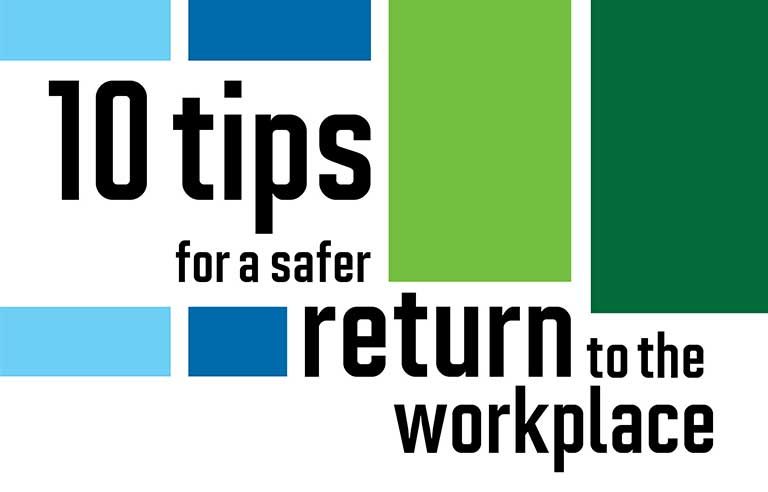10 tips for a safer return to the workplace
Things to think about before bringing workers back

Employers bringing workers back to physical locations – or thinking about it – amid the COVID-19 pandemic have plenty of decisions to make. From mask and vaccine requirements to implementing safety measures such as testing, physical distancing, and frequent cleaning and sanitizing (to name a few), protecting employees from exposure requires creating a comprehensive plan, and then executing that plan and adjusting when necessary.
So, where should you begin?
“Start by looking internally at your own workforce,” advises Stephanie Roberts, program manager for SAFER: Safe Actions for Employee Returns – a National Safety Council initiative aimed at developing industry- and risk-specific resources and recommendations for employers. “How at risk are your workers? Looking at some of those things can really help decisions on how to safely expand operations.”
Here are 10 key focus areas to help guide a safer in-person return to offices and workplaces.
Know your workforce
First, employers should identify where exposure could occur.
“Look at if it’s a people-facing environment,” Roberts said. “Are they working closely together at a plant or con-struction site? Are they in an office?”
The most common safety measures recommended by the Centers for Disease Control and Prevention are masking, physical distancing, and enhanced cleaning and disinfecting of workplaces. SAFER and CDC guidance also includes increasing ventilation and air filtration; providing necessary personal protective equipment based on a worker’s risk exposure; reducing touch points by having lights that operate on sensors; and installing hands-free, arm-pull or foot-operated door openers wherever possible.
Roberts adds: Company leaders should know whether their workers are vaccinated. They also should decide 1) if they’re going to require proof of vaccination and 2) whether they plan to encourage, incentivize or mandate vaccinations.
Examine your workspace
Start by assessing the space in your facility before workers return. How can you make sure they’re safely distanced?
For workstations and common areas, restrict the number of people by setting capacity limits. Another strategy: Rearrange seats and furniture in gathering places such as cafeterias, meeting rooms and locker rooms in a way that allows for physical distancing. The flow of foot traffic can be adjusted by designating stairwells for going up or down, and separate doors as entrances and exits.
To avoid exceeding maximum capacity, use a hybrid schedule in which employees rotate days they come into the facility or work remotely, if feasible.
In addition, a formal assessment of the workplace can determine what rooms or gathering areas can be closed off, according to SAFER.Another consideration to keep in mind is the length of time the facility was shut down. For those that were un-occupied for prolonged periods, CDC encourages checking for mold growth and rodents/pests that have found their way in, increasing circulation of outdoor air, and testing water systems to minimize the risk of Legionnaires’ disease and other diseases associated with water.
Enhance communication
Communication will be imperative once workers – who have been meeting virtually throughout the pandemic – return to the physical workplace. This might mean encouraging safely distanced visits to a colleague’s work-station or a manager’s office. For in-person group meetings, allow workers to express their concerns and ask questions without fear of retaliation.
“Maybe set aside the last five to 10 minutes of a meeting where you’re giving updates,” Roberts said. “In the COVID-19 landscape, everything is constantly changing.”
Create a welcome wagon
Bringing employees back to the workplace calls for a welcoming committee, of sorts. “Even if workers have already seen it, they might not have been there for a year and a half,” Roberts said.
That calls for explaining what policy changes have been made regarding meeting spaces, work locations and building foot traffic flow.
“Almost like a tour if they’re a new employee, whether they are or not,” Roberts said. “Set aside time and be really intentional to get them reacclimated.”
Stay on top of what’s working
In a survey of nearly 300 organizations, along with two worker surveys with nearly 3,800 respondents, SAFER asked employers and employees what safety measures implemented in their workplace were most effective.
Facemask requirements and newly installed hand sanitizer dispensers were considered the top two control measures by both groups.
The least effective measures, according to the employees, were salary increases for frontline/at-risk workers, increased time between shift changes and at-home COVID-19 testing.
The employers ranked temperature screenings at the facility’s entrance, signage to educate workers on COVID-19 prevention and hygiene, and salary increases as the least effective.
Post a comment to this article
Safety+Health welcomes comments that promote respectful dialogue. Please stay on topic. Comments that contain personal attacks, profanity or abusive language – or those aggressively promoting products or services – will be removed. We reserve the right to determine which comments violate our comment policy. (Anonymous comments are welcome; merely skip the “name” field in the comment box. An email address is required but will not be included with your comment.)


